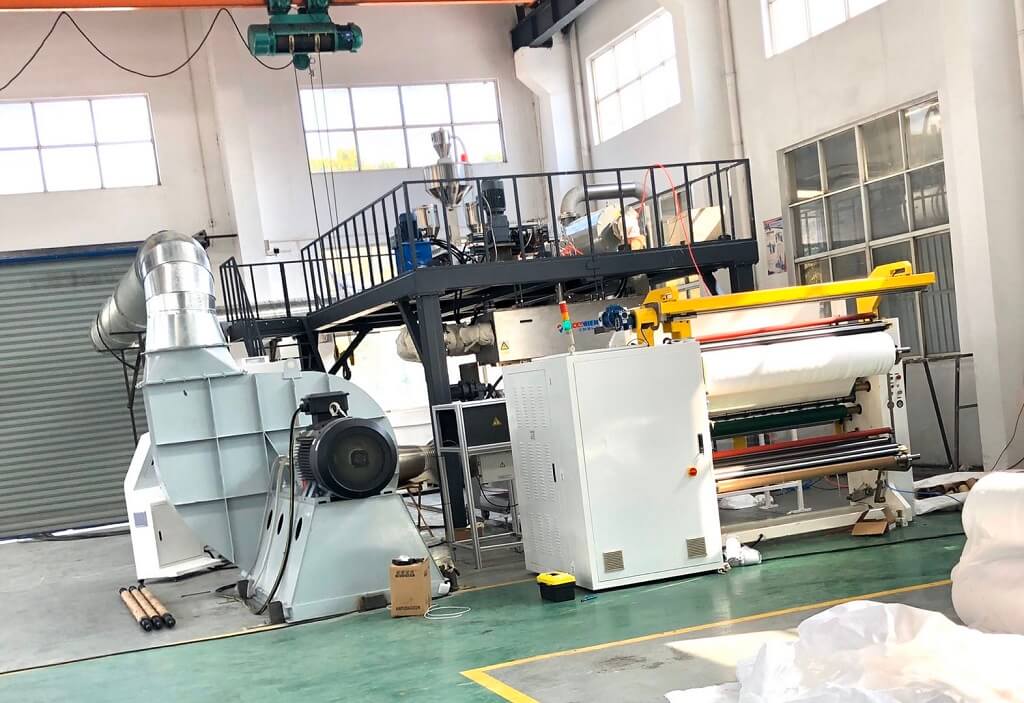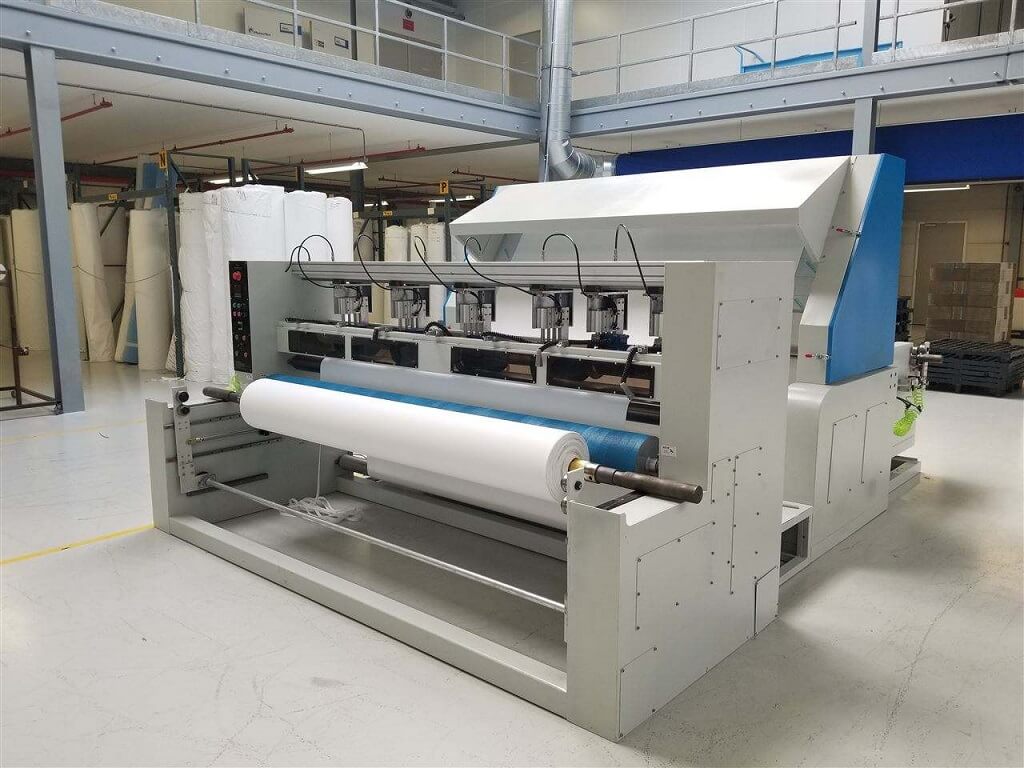Suko is professional PP melt-blown machines manufacture and supplier and we have solved many machine commissioning problems for our customers. We had summarized the various problems that may happened during melt-blown machine commissioning, and shared them with all friends in the industry.
With the spread of COVID-19 in the world, as the core material of medical protective face masks – the melt-blown fabric, has become the protagonist of the COVID-19 epidemic market.
The melt-blown is produced through a high-speed hot air flow to rapidly stretch and solidify the polymer melt that has just been extruded to form a spinning method. The advantage is that the process flow is short, and the non-woven fabric can be directly produced by spinning. The disadvantage is that the equipment needs to be commissioned.
Suko is professional PP melt-blown machines manufacture and supplier and we have solved many machine commissioning problems for our customers.
We had summarized the various problems that may happened during machine commissioning, and shared them with all friends in the industry.
Brief introduction of Melt-blown Machine

The polymer melt extruded by the screw extruder is sprayed with high-speed and high-temperature air so that the melt stream is extremely stretched to form ultra-fine fibers. These ultra-fine fibers are condensed on the roller to form the non-woven filter fabric.
Process flow: polymer powder feeding → melt extrusion → fiber formation → fiber cooling → adhesive reinforcement → trimmed winding → non-woven filter fabric.
Steps of Melt-blown Machine Commissioning
1. Set at a higher temperature and wind pressure to make the melt-blown machine spray a softer fabric.
2. Then fine-tune the temperature of the die and hot air until the fabric feels a bit hard.
3. Record the die temperature and the temperature of each area of screw.
4. Fine-tune the wind pressure, screw speed and melt extrusion amount to make the fabric soft again.
5. Adjust the winding speed to make the weight of the fabric reach the standard.
6. Add two electrets according to the speed of fabric collector. Generally, the electret is 5-7 cm away from the fabric, and the static voltage is 40kv-60kv. If the speed of fabric collector is slow, just add a static electret.
Initial Parameter Settings
1. Screw temperature: set 190℃ in the first zone, 200℃ in the second zone, 210℃ in the third zone, etc.
2. Die head temperature: 250℃ (generally 240-255℃).
3. Heating package temperature: internal temperature 300℃, outlet hot air temperature 270℃.
4. Quick fiber net changer, metering pump, die head filter: 240℃.
5. Hot air pressure: 0.2-0.4MPa. General high-melt PP material, the air pressure can be set on 0.2-0.3MPa. The air pressure of the material around 1300 can be higher. Set the air pressure according to different melt-blown machines and die heads.
6. Melt-blown fabric collect distance: 15-25 cm, mostly are 15-20 cm.
7. The size of the air outlet is the same as the distance from the tip of the spinneret to the plane, 1-2mm.
8. The screw speed is moderate or smaller (small wind pressure, smaller extrusion volume, large wind pressure, larger extrusion volume).

Exception handling
1. If the melt-blown fabric is still not soft under a relatively high temperature temperature, the problems may include: a. temperature sensor problem; b. temperature controller problem. If these two problems are eliminated, you can increase the temperature until the soft melt-blown fabric came out. Note that excessive temperature will cause crystallization phenomena.
2. Large melt-blown equipment uses melt-blown material with a melt of about 1500, and small equipment can use melt-blown material around 1300.
3. If the die temperature is set at about 210-230℃, and the wind pressure is below 0.2Mpa, the machine will have a phenomenon of flying material, which may be abnormal in the following aspects: a. temperature sensor problem; b. air pressure problem; c. the size and angle of the air outlet are abnormal.
4. If the melt-blown fabric is still not soft or starts to be brittle when it is added to a very high temperature, the fabric will start to soften after further increasing the processing temperature. Most of the reasons are the melt-blown machine problems. It is recommended to contact the equipment manufacturer. Of course, it is also necessary to rule out whether there are serious quality problems with the materials.
5. The addition of electret master batch in production generally requires proper process parameter adjustment to match it. Using different electret master batches, the process parameter settings of the same melt-blown machine are different. You can refer to the above adjustment process to adjust the melt-blown cloth to the best state, and then compare and test the performance.
6. The greater the amount of electret master batch, the better the electrostatic effect. But after reaching 6%, the effect peaked. The higher the addition ratio, the greater the effect on the finished melt-blown non-woven fabric.
Statement of ctrostatic attenuation
- After the melt-blown fabric is treated with electret, both the electret master batch and the PP material can be charged with static electricity. The static electricity on the electret master batch with a small amount of addition can increase the stable filtration rate by about 10-20%, the decay is very slow under packaging and storage conditions.
2. The decrease in filtration rate is generally due to a small amount of electret attenuation of static electret and a large amount of melt blown pp.
3. Some melt-blown fabrics are soft but their toughness is insufficient. As storage time increases, the fabrics will become brittle. And it is easy to cause a decrease in filtration rate. This melt-blown fabrics is usually produced under the condition of relatively high die temperature and hot air temperature.
4. Unstable filtration rate can be changed by following these ways. First of all, without adding electret master batch and electret treatment, make a melt-blown cloth with higher basic physical filtration efficiency. On this basis, no electret treatment can be added, only add electret master batch to test the difference in filtration rate. Because a good electret master batch can generate static electricity during the winding process without the electret treatment, which can improve the filtration rate of the melt-blown fabric.
5. The physical filtration rate of the melt-blown fabric is the foundation, and the electret master batch is the key so that a relatively stable filtration efficiency can be achieved.
6. Different melt-blown machine can make different melt-blown fabric, especially the quality of the die. Some melt-blown machine can only achieve 85% filtration rate. If you want to reach 90% or higher, you need higher quality PP materials.
Adjustment method of melt-blown fabric becoming brittle and hard
1. From the melt-blown machine, it is mainly caused by the following reasons: a. uneven spinning, b. uneven heat dissipation caused by insufficient negative air return air volume, and internal stress causes brittleness. Increasing the air volume of the cooling fan, adjusting the melt volume of the extruder, and adjusting the temperature of the hot air can improve this problem.
2. From the perspective of PP materials, use low-melt grease PP material can cause the spinner to be thicker. After cooling and crystallization completely, it will make the melt-blown fabric brittle and hard. Preference is given to melt-blown materials with a melting index of around 1500. The filaments are thin, soft and evenly distributed, and the resulting melt-blown fabric is soft.
3. If the initiator of the peroxide process in the production process of the melt-blown material is not well controlled, the fabric is prone to brittle and hard problems. If the PP material and processing temperature are too high, it will be overheated inside the screw and severely thermally degraded. In the material production process, the peroxide process needs to complete the molecular chain break before the screw is extruded, to prevent the secondary residue from entering the non-woven fabric screw to continue the reaction. This requires a good combination of recipe control and screw equipment.
4. There is no return air fan for collecting with a roller. After the winding, the temperature of the melt-blown fabric is high and the heat can not be quickly dissipated. After cooling, it will become brittle.
5. For small melt-blown machines, the problem of brittleness and stiffness can be solved by selecting compound formula PP raw materials.
How to improve the toughness of melt-blown fabric
1. Reduce the melt-blown fabric receiving distance and fine-tune the hot air flow or temperature appropriately. If the ambient temperature is too high, you can increase the bottom suction.
2. Decrease the extrusion speed and reduce the output.
3. Increase the fiber fineness and reduce the spinning ambient temperature.
4. Adopt PP material of compound formula.
The above are a summary of our worker’s practical experience. Of course, the problems and methods of adjusting the melt-blown machine are far more than those above. If you have any questions on the machine and materials, you can contact us [email protected]
Post time: May-17-2020

